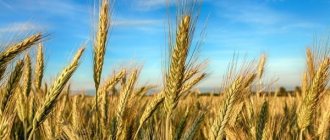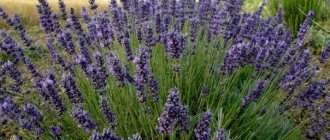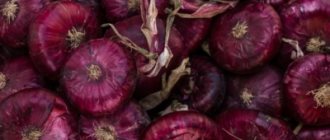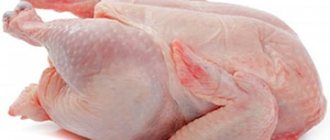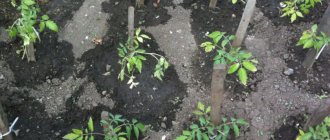What are the features of growing winter rye?
The main advantage of growing winter rye is the winter hardiness of the crop . Crops can easily withstand cold temperatures down to -25...-30°C, even if there is no snow cover. In harsh conditions, the yield of some varieties is 20-30 centners per hectare. Wheat simply cannot withstand such frosts.
Winter rye varieties branch well; 3-8 spikelets grow from one grain . The plants grow quickly, displacing weeds from the fields, including wild oats and thistle. Winter rye is used as a precursor before sowing row crops and spring cereals. They are grown in soils with high acidity, which wheat and other cereals cannot tolerate.
Winter rye is used as an early green manure in organic farming . It displaces weeds and loosens the soil. Long roots lift useful minerals from deep layers of soil. After warm weather sets in, the young shoots are cut off and the main crop is sown on the field.
Mown rye quickly rots and serves as fertilizer for new plantings.
How rye grows
Rye is a herbaceous annual plant with a hollow, bare stem . Cultivated varieties have an average height of 80-100 cm.
Other characteristics:
- leaves are fleecy, with a characteristic bluish color;
- the root system is fibrous, branched, reaches a depth of 1-2 m;
- from each seed 6-8 shoots grow, under favorable conditions - up to 90;
- the stem ends in two-row spikelets;
- the fruit is an elongated (5-10 mm), slightly laterally pressed grain, 1-3 mm thick.
The weight of a thousand seeds depends on the variety . In diploid seeds, 1000 seeds weigh 20-35 g, in tetraploid seeds - 50-55 g.
Interesting things on the site:
Varieties of rye: seed, winter and other varieties
What kind of cereal is made from rye and its beneficial properties
Where is it grown?
Rye was the main grain crop in Europe for a long time , after which it gave way to wheat and barley. It is believed that the ancestral home of modern cultivated species was Turkey, where rye was considered a weed. After the spread of grain farming in the northern territories, people paid attention to cereals due to its cold resistance.
Now rye is grown in many countries . In the Russian Federation, the most favorable regions for the cultivation of cereals are the republics of Bashkiria and Tatarstan, Orenburg, Saratov, Kirov and Volgograd regions.
In Yakutia and Transbaikalia, only spring varieties are grown, since winter varieties are not able to survive very cold winters.
In the southern districts and regions of the Russian Federation, rye is not grown, since the fields are allocated to more productive and valuable crops: wheat, corn, sunflower.
Methods of tillage for winter crops
Before planting winter varieties, the soil is carefully cultivated: cultivated in the spring-summer period (at least 4 times) and the soil is peeled using the autumn method. During the first plowing, harrowing is used; if the soil is subject to deflation, walk-behind tractors and subsoilers are used.
In order for the soil to be structural, dense, and contain a sufficient amount of moisture and nutrients, the following are planted: oat vetch, fodder lupine and other green mixtures. After planting a fallow crop, the soil acquires the necessary supply of valuable substances, micro and macro elements for winter crops and ensures the cleanliness of the field. Before planting, treatment is carried out using the fallow method or limited to surface techniques.
Optimal growing conditions
Rye is a temperate crop . Seeds germinate at a temperature of +1…+2°С, for germination they need to rise to +4…+5°С. A decrease in temperature in autumn has little effect on the growing season. The stems bush well at +12°C and stop growing at +3…+4°C. Sharp, prolonged cold spells in the spring can slow down development.
The culture is light-loving . Plants develop quickly with long daylight hours. With sufficient light, rye grows well, ears form on all stems. With shortened daylight hours, abundant branching begins without the formation of spikelets.
Important . Only dry seeds can be stored; after getting wet, the grains quickly die if the temperature drops below 0°C.
Habitat: why is rye demanding?
The culture loves moisture. For seed germination, soil moisture must be above 21.8% . In this case, the first shoots appear already on the third day after sowing. When humidity decreases to 18.5%, development slows down. Shoots appear only after a week.
During the growing season, especially tillering and flowering, the need for moisture increases sharply . Plants from 1 hectare consume up to 1600 tons of water from the soil during the growth of green mass. Therefore, in arid regions the possibility of irrigation must be provided. After flowering, rye's need for water drops significantly.
The cereal crop grows on soils of varying acidity (pH=5.3-6.5). It is grown in regions with podzolic soils, chernozems, and structured forest loams.
Pollination of rye requires warm, dry weather with a light breeze . With strong humidity, windiness, and cold weather, pollen dies.
Predecessors
The best predecessors for winter rye are perennial leguminous grasses, pelyushko-, pea- and vetch-oat mixtures, early ripening varieties of buckwheat, lupine for green mass, early potatoes, winter rapeseed. Rye is placed in fertile areas after oats, in row crop rotation after barley, which was cultivated after potatoes fertilized with manure. The main requirement for predecessors is timely clearing of the field in order to clear it of weeds, preserve and accumulate moisture. Winter rye is a good predecessor for other crops - corn, potatoes, root crops.
Cultivation technology
To obtain a harvest, winter rye is planted in clean, busy and green manure fallows , if the crop is provided with adequate moisture. The sowing period for winter crops depends on the characteristics of the variety and climatic conditions, on average 50 days before the temperature drops below +4...+5°C. During this time, the seedlings will germinate enough to withstand the winter cold.
Interesting . Rye is sometimes planted in early spring. In such cases, vernalization is first carried out: the seeds are germinated to 1 mm, sprinkled with a moist substrate and grown in the refrigerator for about a month, after which they are sown.
Soil and seed preparation
Before sowing winter rye, fertilizers are applied . It is better to use organic: manure, compost. The norm is 30-35 kg/ha for poor soils and 15-20 kg/ha for chernozems. When sowing after late spike predecessors, the dosage increases to 40-45 kg/ha. When sowing, superphosphate is applied on time - 50 kg/ha. Soil acidity is reduced with lime fertilizers to 3-5 t/ha.
High-quality planting material is selected for sowing:
- grain germination rate more than 92%;
- purity above 97%;
- weight of 1000 seeds is not less than 35 g;
- growth force 80% or more.
Before planting , the seeds are treated to prevent infection with fusarium and helminthosporium rot, ergot and other diseases. Freshly harvested grains are heated in the sun for 3-5 days or in a grain dryer for 2-3 hours.
Sowing
It is recommended to sow winter rye when the average daily temperature drops below +15°C . This reduces the likelihood of crop damage by insects and accelerates seed hardening.
Most often, narrow-row sowing is used with row spacing of 7-8 cm. The seeds are buried no more than 5 cm, otherwise the yield drops catastrophically.
Rye care
After sowing, the seeds are rolled, harrowed, and, if necessary, the fields are treated with herbicides and retardants. Rolling can be done immediately after planting if there are ring rollers. Compacting and leveling the soil has a beneficial effect on seed germination.
As the rye develops, it is fed with nitrogen fertilizers: 30-40 kg/ha at the stage of intensive growth and when buds are formed.
Crop protection
In the fall, after the growth of seedlings has slowed down, plants are treated against root rot and snow mold . In winter, snow retention work is carried out. In the spring, fields are harrowed if possible. Typically, nature “gives” only 4-5 days for this type of processing, since after warming the rye begins to grow quickly.
To prevent the appearance of fungi, fields are treated with fungicides; when weeds appear, targeted herbicides are used.
Use of rye: tasty and healthy
The dried grains are ground into flour, from which they make cereal or bake very nutritious and healthy black bread. It is considered a product of rich people. Moreover, the bran, straw and chaff of the crop are used to feed livestock. In addition, many will be interested in learning how to germinate rye. First, the grains are sorted and then soaked (the water should cover them by 1.5 cm).
The technology of this process is very simple:
- the container is placed in a warm room;
- change the fluid every 3 hours for 12 hours;
- after the time has passed, the grains are washed under running water;
- they are placed in a bowl and covered with moistened gauze (the cloth is folded 5-6 times);
- The dishes are left in this condition for 4-6 hours.
Since it is quite easy to germinate rye, this procedure is repeated several times a season. Store it in the refrigerator for 5 days. Wash thoroughly before use. Doctors recommend chewing the grains well so that the beneficial ingredients are absorbed faster.
This completes the process of growing rye. However, farmers are looking forward to autumn or spring to sow crops again.
When the rye blooms
The fields begin to bloom 7-10 days after heading . Flowering lasts up to two weeks. In hot weather, the period can be shortened to 6-8 days. With increased humidity and cold weather, the anthers do not open, and flowering lasts longer.
The flowers open several times during the day for 15-30 minutes, after which they close. The first buds bloom in the middle part of the ear, then flowering spreads to the edges.
When it is removed from the fields
Rye is harvested in the middle of the waxy ripeness stage . When harvesting, speed is important. When rye ripens, 4-6 days after the end of waxy ripeness, the grains begin to rapidly fall off, and the harvest is lost.
Fertilizer system
For basic soil cultivation, mineral fertilizers are applied on the basis that with one ton of grain and the corresponding amount of straw, 10-12 kg of a.m. are removed from the soil. phosphorus, 20-25 kg a.i. potassium, 25-28 kg a.i. nitrogen. At a yield level of 41-50 c/ha, the approximate dose of phosphorus fertilizers is 80-90 kg/ha a.i. They are applied in two stages: 6075 kg/ha a.i. in the main treatment and 10-15 kg/ha a.i. - in rows when sowing. Doses of potassium fertilizers in the main treatment are 90-120 kg/ha a.i. Nitrogen fertilizers are applied in the spring as top dressing. Small doses of nitrogen fertilizers (20-30 kg/ha a.i.) are recommended to be applied in the fall only under unfavorable weather conditions for autumn sowing, delays in sowing dates, poorly cultivated soil, and plowing of straw after stubble predecessors.
Harvest
Single-phase harvesting is performed with combines when the grain moisture content decreases to 20% . Due to the short harvesting period and the rapid fall of seeds, separate harvesting is often used. The rye is mowed and placed in windrows. After a few days, the stems and grain dry out. The windrows are collected and threshed. This method reduces grain loss due to shedding.
Winter rye yield
The crop yield depends on the region of cultivation , the selected variety or hybrid and is about 20 c/ha. For example, in the Republic of Kalmykia, farmers manage to collect an average of 9 c/g, and in the Krasnodar Territory - 37 c/ha.
Preserving the nutritional value of grain
How to maintain the productivity potential and nutritional value of harvested grain? This can only be realized if all agrotechnical standards are observed: rules for tillage, planting, harvesting and proper threshing. In addition, the growing conditions are important - the composition of the soil, the absence of weeds, diseases and proper sowing with drainage structures and the structure of the furrows that preserve the plants from frost and rotting. Such conditions can only be ensured by a professional approach and modern agricultural technologies, choosing high-quality seed mass, fertilizers and equipment and performing all work on time.
How to care for crops?
Winter rye grows quickly, and usually there are no problems with it. But it is extremely important to follow the basics of care! The standard crop care package includes harrowing, treatment with herbicides against diseases, weeds, pests, and rolling.
Rye needs to be treated for diseases
- Rolling helps to compact the soil and at the same time level the field and promote seed germination. This is done both before and after sowing.
- Treatment against diseases (rot, powdery mildew, mold, etc.) can be carried out with any active substances. But it is desirable that these are biological drugs, not chemicals. The latter is not only harmful to health, but is also prohibited in many countries.
- Harrowing retains moisture in the soil, loosens the soil and increases productivity.
Don't forget about regular watering. Water application rates depend on climate and soil type.
Popular varieties
There are many varieties of winter rye, but only a few of them are considered in demand. Such crops are characterized by consistently high yields, resistance to frost, and low maintenance requirements.
Popular varieties of winter rye include:
- Synthetic 38 - reaches 120 centimeters in height and is characterized by pronounced bushiness. The plant is characterized by large oval grains covered with fluff. Germination parameters reach 94%. The culture is resistant to drought, lodging and shedding. It is also characterized by moderate resistance to frost and disease.
- Kharkovskaya 78 - reaches a height of 130 centimeters. It is characterized by dark green grains covered with a pronounced coating. The plant is resistant to frost, dry weather and lodging. It is also characterized by resistance to certain types of diseases - rust, mold, ash.
- Relay race of Tatarstan - a diploid type crop characterized by long prismatic ears. The variety is considered medium late. It is characterized by a high degree of resistance to brown rust and powdery rose. The height of the bushes reaches 125 centimeters.
- Voskhod 2 - is a mid-season variety of domestic selection, which was bred specifically for non-chernozem regions. The culture has a dense spike of prismatic shape. It reaches 8-10 centimeters in length. The grains have a yellow-gray color and an elongated shape. The height of the plant reaches 150 centimeters. The variety is resistant to frost, but does not have very good immunity to major diseases.
- Saratovskaya 7 is considered a mid-season crop. This variety is characterized by high resistance to lodging. The plants have the same height, which greatly facilitates the harvesting process. Another advantage is resistance to major pathologies.

